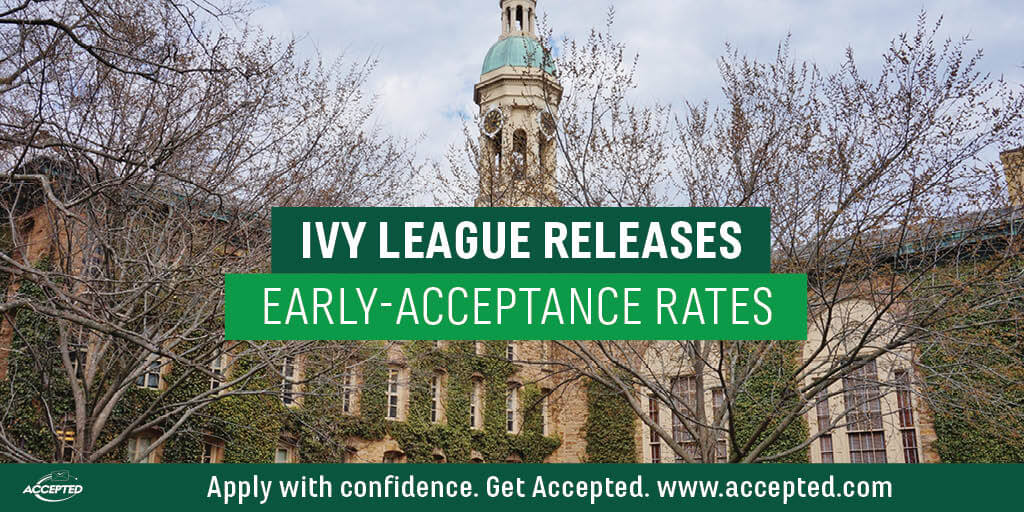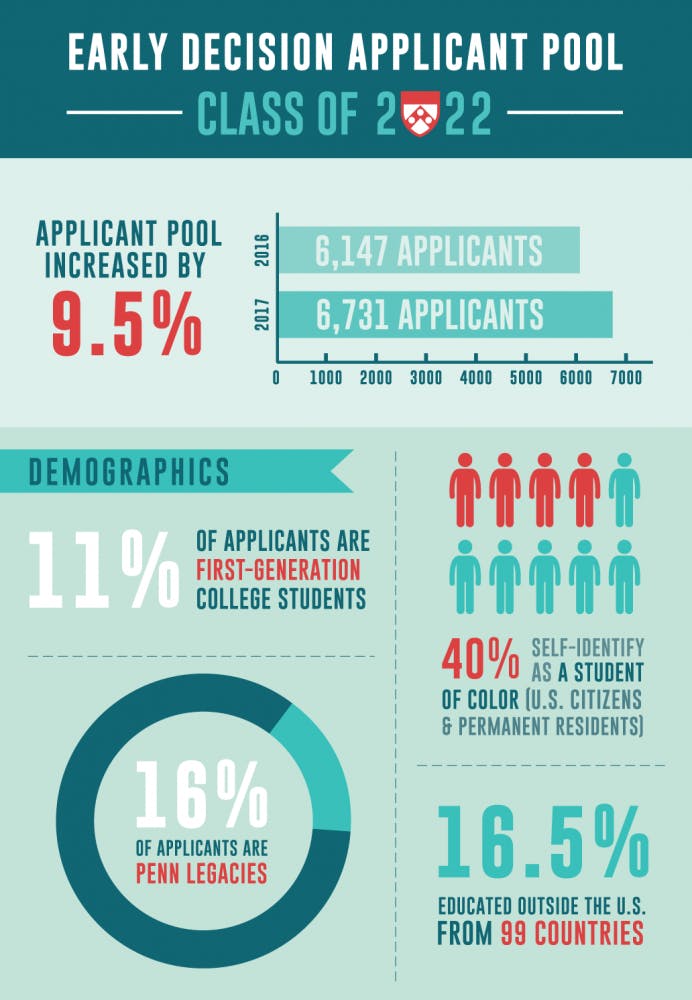So the trend of top schools getting more competitive is still evident after COVID. Certain schools are highlighting slight differences in regards to the percentage of admits that applied with a test score compared to applicants who didn't. Students should certainly take the standardized tests if they are able to, but the differences in admissions numbers aren't significant enough for students to worry unduly about access to SAT/ACT testing. Wall Street Journal is quoted saying, "The University of Pennsylvania admitted 15% of those who applied in its binding early-decision round. While about two-thirds of the applications included test scores, three-quarters of those admitted did".
For instance, at Columbia University, students who applied through the college's early decision program were four times as likely to get in than students who applied later. The school's early decision acceptance rate was 16%, whereas its acceptance rate for regular decision applicants was only 4%. Penn's four undergraduate schools include a college of arts and sciences, a business school, an engineering school, and a school of nursing. No matter which school or major students are enrolled in, Penn emphasizes that all undergraduate students receive a thorough foundation in the liberal arts.
Many students take courses across all four undergraduate schools and choose from countless interdisciplinary minors and dual degrees. Prospective Wharton candidates apply in their senior year of high school either through the early decision process or regular decision process. These candidates are then grouped with a pool of applicants separate from those applying to the University of Pennsylvania's College of Arts and Sciences , School of Engineering and Applied Science , or School of Nursing. Each of the other three schools also forms its own separate pool of applicants. The University of Pennsylvania, which ranks among the20 most selective universities in the country, has a highly competitive admissions pool with a low acceptance rate and high average SAT/ACT scores. However, Penn has a holistic admissions process involving other factors beyond your grades and test scores.
A strong application essay, supplemental essay, and glowing letters of recommendation can strengthen your application, as can participation in meaningful extracurricular activities and a rigorous course schedule. Students with particularly compelling stories or achievements can still receive serious consideration even if their test scores are outside of Penn's average range. Five of the eight Ivy League universities have binding early decision programs that require students who apply early to commit to attend if they are accepted. However, all three of these schools have restrictive early action programs, meaning that early applicants to these schools must abide by certain limits in terms of how and where else they apply early. The massive increase of applicants, and resultant decline in acceptance rates, were a surprise to many in the college industry.
After all, many students were unable to take SAT exams, participate in sports or other extracurricular activities, or even attend classes in person. But they may have gotten a false sense of security from the fact that more than 1,500 colleges and universities – including all eight Ivies – did not require SAT or ACT scores from applicants. Of course, students with stellar test scores did submit their scores for consideration. In addition, virtual outreach events allowed colleges to reach more students than they had in the past when they relied mainly on in-person college visits to entice future applicants. Colleges had already been posting extremely competitive acceptance rates, with eight percent, or fewer, applicants gaining acceptance to the top tier schools, according to statistics from U.S. To increase their chances of acceptance, students frequently choose one university and apply early decision or restrictive early action.
Of the 56,333 students who applied to Penn's Class of 2025 in the early and regular rounds, 3,202 were admitted, leading to an overall acceptance rate of 5.68 percent. The 3,202 admitted students to the Class of 2025 included 1,194 students who were admitted through the early decision round. The admission rate for the ED round was 15 percent out of 7,962 applicants. Last year, 42,205 students applied to Penn's Class of 2024 in the early and regular rounds and 3,404 were admitted, leading to an overall acceptance rate of 8.07 percent. Out of the total 3,404 admitted to the Class of 2024, 1,269 students were admitted through the early decision round. The admission rate for the ED round was 19.67 percent out of 6,453 applicants.
For the Class of 2023, 44,960 students applied to in the early and regular rounds and 3,345 were admitted, leading to an overall acceptance rate of 7.44 percent. Early Decision applications, being binding, also boost colleges' yield rates , which colleges highly value. Record-low admittance rates pervade this year's regular decision applicants at other Ivy League schools, as well. At Brown University, the college admitted just 6.6 percent of applicants overall, and only 4.8 percent among regular-decision applicants.
University Of Pennsylvania Regular Decision Acceptance Rate A reported 38,674 students applied; like Penn, this was the school's largest applicant pool ever. While these are the main categories of non-Regular Decision college applications, it's important for students to research the application guidelines for the individual colleges they're interested in. While Early Decision is a widely offered option, many colleges don't offer it, and each school offers their own application plans and deadlines. Colleges often change the options they offer as well, so checking for their most recent application guidelines is a must! Whatever the case, college-hopefuls should definitely consider the schools on their college list and plan to make the most of the advantages of early applications.
Feel free to request a free consultation with an ILUMIN consultant to get some initial thoughts of how to tackle the early applications and admissions process. In this way, REA allows students to demonstrate exclusive interest to their top-choice college while also retaining flexibility in choosing among their college offers. REA applicants thus benefit from higher acceptance rates, similar to those for Early Decision applicants. Even if a student is accepted in the REA round, they have until May to choose whether or not to commit—the same timing as Regular Decision. Because of this, REA is especially useful for students who, before committing, want to first compare and consider the different financial aid packages that colleges may offer in both the REA and Regular Decision round.
A private, Ivy League university that was founded in 1740, the University of Pennsylvania is a colonial school that was founded before the U.S. was established. This college is located in Philadelphia, Pennsylvania and is steeped in history and tradition. It is a medium-sized university with an undergraduate enrollment of 10,183 students. If you want to attend this school, you will need to earn a top high school GPA and excellent standardized test scores.
You will also need to write a very compelling essay and have engaged in extracurricular activities that demonstrate your extraordinary talents and abilities. StudyPoint is a national leader in one-to-one, in-home test prep and academic tutoring. The test-taking techniques and strategies taught in our SAT tutoring and ACT tutoring programs enable students to earn higher test scores and gain admissions to competitive colleges and universities. Our expert subject tutors and personalized lesson plans help students earn better grades and become happier, more confident students. Whether you're looking for a math tutor or any other type of academic tutoring, StudyPoint can help.
To learn about tutoring programs in your area, feel free to contact us for more information. The University of Pennsylvania, founded by Benjamin Franklin in 1740, is an historic and highly selective member of the Ivy League. With over 10,000 undergraduates from every state and many countries, the University prides itself on its diversity. The University also boasts The Wharton School, ranked as one of the top three business schools in the country.
UPenn's interdisciplinary character carries over into its research endeavors. With a research budget of more than $800 million per year and 165 research centers, it is one of the top research universities in the country. As a result, many undergraduates have the opportunity to engage in research projects of their own during their time here. Timing and application strategy are key in selective admissions, and applying in the early round can improve the chances of getting an acceptance letter – but only if students are ready.
This is why it's important to maintain anupward grade trend throughout high school, take challenging courses every year, and start building a balanced college list early. Down from its previous admission rate of 5.6% in 2020, Princeton is even more competitive to get into now with a 4.4% acceptance rate. The Ivy aims to identify students who will positively contribute and bring a unique perspective to its community. Rather than looking for a specific set of academic criteria, Princeton prefers applicants who have challenged themselves with rigorous honors and AP courses. The University of Pennsylvania offered admission to a record-low percentage of applicants for its class of 2023.
The college also received a record number of applications from prospective students. The downward trend for admissions at Penn is in line with rates at other Ivy League schools. Williams College accepted 255 students (31.3% acceptance) to the Class of 2026 through this year's early decision admissions process. There were 814 total early applicants, of whom around 180 were deferred to the spring's regular decision pool, with the remaining 400 or so denied admission. The average acceptance rate among Ivy League colleges in fall 2019 was 7%, U.S.
The average acceptance rate at all other National Universities — schools that offer a full range of undergraduate majors, plus master's and doctoral programs — was about 65.5% for the same time period. Brown adopted its current Early Decision policy 18 years ago, yet the university received more Early Decision applications than ever for its Class of 2024. In 2020, 4,562 students applied for Early Decision, and 800 earned admission — a rate of 17.5 percent. In the Regular Decision round, 32,232 students applied, and 1,733 were accepted — a rate of 5.4 percent. Between Early Decision and Regular Decision, 36,794 students applied to Brown. Overall, the acceptance rate for Brown's Class of 2024 was approximately 6.9 percent, which is up slightly from 6.6 percent for the Class of 2023, after a trend of rapid decline that spanned a few years.
A total of 5,777 Early Action applications flew into the mailboxes of Yale University in the 2020 admissions cycle. Of these 5,777 applicants, 796 were admitted to Yale's Class of 2024, at an EA admission rate of about 13.7 percent. (In 2019, the rate was 13.2 percent for the Class of 2023.) As for Regular Decision, 1,508 students were accepted of 29,443 applicants, at a rate of 5 percent. In total, 2,304 students were accepted from a pool of 35,220 applicants, at a rate of 6.54 percent. Although schools are reporting lower acceptance rates for early applicants, students who apply early still have a better chance at acceptance than they do in the regular admissions period. University of Pennsylvania received 44,961 undergraduate applications in 2019, which represents a 1.06% annual growth.
Out of those 44,961 applicants, 3,446 students were accepted for enrollment, representing a 7.66% acceptance rate. Last year, every single one of Ivy Coach's students who completed applications with us and applied Early Decision earned admission. This included a perfect sweep of the eight Ivy League schools, Stanford, MIT, Duke, Northwestern, and more.
This year, unlike last year, we cannot report a streak of perfection across all highly selective universities — although we are perfect at multiple Ivy League schools . While we congratulate our Ivy Coach students who earned admission to UPenn this Early cycle, we did have a deferral. Well, consistent with the trend at the vast majority of our nation's elite universities, applications skyrocketed. In fact, applications soared by 23% from this time last year, which isn't quite as high as Dartmouth College's 29% jump but it's pretty significant nonetheless. Simply having great grades and superb standardized test scores is not enough to earn admission to a highly selective school such as UPenn, since nearly every applicant is academically qualified. A whopping 56,333 applications were received by Penn for the Class of 2025, the largest applicant pool to date; only 3,202 individuals were accepted.
Working out to 5.68% acceptance rate, this was the most selective year in the university's lengthy history. Applicants for the Classes of 2016 and 2017 saw admit rates in excess of 12%; the Class of 2018 is when the school's admit rate first dipped below 10%. The two years prior to the Class of 2025 cycle, 8.07% and 7.4% were accepted.
To apply to the University of Pennsylvania, choose either the Coalition or Common Application. You should start early regardless of which application process you choose. Make sure to notify the teachers that you want to write recommendations for you in plenty of time, and start working on your essays as early as possible. Fill out your application and your financial aid materials, and submit everything well within the deadlines. The University of Pennsylvania offers a detailed application checklist that can help you to stay on track. Make sure to have all of your standardized test scores sent directly to the University of Pennsylvania.
The University of Pennsylvania is one of the most selective universities in the U.S. The school received 44,961 applications for the entering class of 2023 and accepted 3,346. The University of Pennsylvania received 7,109 early decision applications and admitted 1,280 for an early decision admission rate of 18%. The regular decision admission rate was 5.7% out of 37,852 applications received. In the scattergram, the blue and green represent accepted students. You can see that the great majority of admitted students had a self-reported GPA of 3.7 or higher, a combined SAT score (ERW+M) of over 1200, and an ACT composite of 24 or higher.
Hidden beneath the blue and green in the upper right corner of the graph is a lot of red, so keep in mind that even students who seem to be on target for admission get rejected from Penn. For any school with a single digit acceptance rate, it is best to consider the institution a reach school, even if your scores are on target for admission. Applying early can also benefit certain types of applicants, including athletes, legacies, and some international students. Colleges are looking to build well-rounded classes made up of specialists, and many times there is only so much room for students within a particular applicant category.
Stanford states that a student's academic record is the most important factor in determining admission, but it also looks at components beyond numerical data. Through a holistic admissions process, the university gives weight to extracurricular activities and personal essays, both of which allow students to illustrate their individual backgrounds and experiences. Note that because many schools have temporarily gone test-optional in response to the COVID-19 pandemic, fewer are reporting middle 50% SAT/ACT scores. This change in policy has led to a surge in applications at many selective institutions, resulting in unprecedented application numbers and some of the lowest acceptance rates in U.S. history.
The Ivy League universities, including Harvard, Princeton, and Penn, have said they will delay announcing admissions decisions until April 6, about a week later than normal, to allow more time. Regular Decision applicants numbered at 42,959, of whom 3,788 were accepted to the Class of 2023 — an 8.82 percent acceptance rate. Among the overall pool of applicants, 49,118 students submitted applications, and 5,183 were admitted at a rate of 10.5 percent. (This acceptance rate is a minor increase from 2018's 10.3 percent.) The total number of students admitted after all things were considered was 5,330.
Each year the University of Pennsylvania receives approximately 23,000 undergraduate applications and admits about 4,000 students. Its 18% acceptance rate that makes it one of the most selective universities in the country. The Early Decision option is available for students who make UPenn their first choice and agree to matriculate, if accepted. There is a slightly higher acceptance rate for students who use this option.
The most competitive applicants have earned high grades and undertaken rigorous coursework. This weight toward academic achievement is made evident by Penn's fall 2020 incoming class statistics, in which 97% of admitted students were in the top 10% of their high school class. Columbia takes a holistic approach to its undergraduate admissions process, assessing each student's unique experiences and background, as well as their academic achievements.
To evaluate a student's academic record, the university looks at the rigor and variety of classes taken and the grades earned in those courses. Even taking Penn's latest news release at face value, Penn experienced at minimum a nine percent drop in ED applications in 2019 compared to 2018. Accepting Penn's latest numbers also means that Penn's ED acceptance rate for Fall 2019 rose to 19.7% after hitting 18.5% in 2018 when Penn accepted 1,279 ED applicants. Penn has now accepted over half of its Class of 2024, which Penn expects to total 2,400 students, via Early Decision. For the class of 2024, Harvard had a total 6,424 Early Action applicants, and offered admission to 895 of them — an admissions rate of 13.9 percent, up slightly from the previous year's record low of 13.4 percent. The total number of applicants is 40,248, of which 1,980 were accepted.
That's a 4.92 percent rate of admission, up slightly from the previous year's record low of 4.5 percent admitted. That figure combines those who applied through regular decision with those who were deferred from early decision. However, early decision may not be the best choice of action for students who need the fall semester of their senior year to improve test scores, GPA, or activities profile. For the Class of 2021, 1,354 students were admitted through the early admissions process. Total early applications totaled 6,147, yielding an early acceptance rate of 22%.
Early applications increased by 6.7% over last year from 5,762 to 6,147. If you choose to apply through the early decision process, you will be notified about whether your application has been accepted, denied, or deferred in mid-December. If it is deferred, it will be considered during the regular decision process. You should submit additional material that demonstrates your further accomplishments to be considered by the admissions office. If you are deferred and then accepted, you will need to make your decision about whether to enroll by May 1.




















